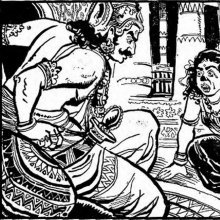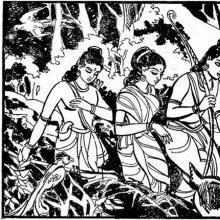Dandakaranya, Damdakaranya, Dandaka-aranya, Daṇḍakāraṇya: 12 definitions
Introduction:
Dandakaranya means something in Hinduism, Sanskrit, Jainism, Prakrit, Marathi. If you want to know the exact meaning, history, etymology or English translation of this term then check out the descriptions on this page. Add your comment or reference to a book if you want to contribute to this summary article.
Images (photo gallery)
In Hinduism
Purana and Itihasa (epic history)
Source: archive.org: Puranic EncyclopediaDaṇḍakāraṇya (दण्डकारण्य).—A forest in the Indo-Gangetic Valley. For the story of how this place became a great forest see under Arā. Other information. (1) This is a holy place. He who takes bath in this place would get the fruits of giving a thousand cows as gift. (Mahābhārata Vana Parva, Chapter 85, Stanza 41).
During the time of the forest life of Śrī Rāma he made his cottage in this forest and stayed there for a while. It was in this forest that a part of the body of Śūrpaṇakhā was cut off and the infantry of fourteen thousand giants who came under the leadership of Khara, Dūṣaṇa and Triśira was completely destroyed. Sītā was stolen, Mārīca was killed by Śrī Rāma, and Jaṭāyu died by the sword of Rāvaṇa in this forest of Daṇḍakāraṇya. (Mahābhārata Vana Parva, Chapters 277 to 279.) (See full article at Story of Daṇḍakāraṇya from the Puranic encyclopaedia by Vettam Mani)
Source: archive.org: Shiva Purana - English TranslationDaṇḍakāraṇya (दण्डकारण्य) or simply Daṇḍaka is the name of a forest, according to the Śivapurāṇa 2.2.24. Accordingly as Brahmā narrated to Nārada:—“[...] Once Śiva accompanied by Satī and seated on His Bull wandered over the Earth, in one of his sportive activities. Wandering over the ocean-girt Earth He reached Daṇḍaka forest [viz., daṇḍakāraṇya] where the lord of truthful stake and transaction pointed to Satī the beauty of the surrounding nature. There Śiva saw Rāma who was searching for Sitā who was deceitfully abducted by Rāvaṇa. Lakṣmaṇa too was there”.
Source: JatLand: List of Mahabharata people and placesDaṇḍakāraṇya (दण्डकारण्य) refers to the name of a Forest or Tīrtha (pilgrim’s destination) mentioned in the Mahābhārata (cf. III.83.38). Note: The Mahābhārata (mentioning Daṇḍakāraṇya) is a Sanskrit epic poem consisting of 100,000 ślokas (metrical verses) and is over 2000 years old.

The Purana (पुराण, purāṇas) refers to Sanskrit literature preserving ancient India’s vast cultural history, including historical legends, religious ceremonies, various arts and sciences. The eighteen mahapuranas total over 400,000 shlokas (metrical couplets) and date to at least several centuries BCE.
In Jainism
General definition (in Jainism)
Source: archive.org: TrisastisalakapurusacaritraDaṇḍakāraṇya (दण्डकारण्य) is the name of a forest in the Deccan, according to the Jain Ramayana and chapter 7.5 [The kidnapping of Sītā] of Hemacandra’s 11th century Triṣaṣṭiśalākāpuruṣacaritra: an ancient Sanskrit epic poem narrating the history and legends of sixty-three illustrious persons in Jainism.—Accordingly, “[...] Then the best of Raghus set forth after taking leave of Suraprabha and fearlessly entered the extraordinary Daṇḍakāraṇya. Kākutstha made his dwelling in a cave-house in a large mountain in it and remained as comfortable as in his own house”.

Jainism is an Indian religion of Dharma whose doctrine revolves around harmlessness (ahimsa) towards every living being. The two major branches (Digambara and Svetambara) of Jainism stimulate self-control (or, shramana, ‘self-reliance’) and spiritual development through a path of peace for the soul to progess to the ultimate goal.
Languages of India and abroad
Marathi-English dictionary
Source: DDSA: The Molesworth Marathi and English Dictionarydaṇḍakāraṇya (दंडकारण्य).—n S The peninsular forest, the country from between the narmadā & gōdāvarī rivers to the south. This was in the days of Rama one large forest.
Marathi is an Indo-European language having over 70 million native speakers people in (predominantly) Maharashtra India. Marathi, like many other Indo-Aryan languages, evolved from early forms of Prakrit, which itself is a subset of Sanskrit, one of the most ancient languages of the world.
Sanskrit dictionary
Source: DDSA: The practical Sanskrit-English dictionaryDaṇḍakāraṇya (दण्डकारण्य).—the Daṇḍaka forest in the Deccan; Mahābhārata (Bombay) 3; also दण्डकावनम् (daṇḍakāvanam).
Derivable forms: daṇḍakāraṇyam (दण्डकारण्यम्).
Daṇḍakāraṇya is a Sanskrit compound consisting of the terms daṇḍaka and araṇya (अरण्य).
Source: Cologne Digital Sanskrit Dictionaries: Shabda-Sagara Sanskrit-English DictionaryDaṇḍakāraṇya (दण्डकारण्य).—n.
(-ṇyaṃ) The peninsula, the peninsular forest: see the last. E. daṇḍaka, and araṇya a wood.
Source: Cologne Digital Sanskrit Dictionaries: Cappeller Sanskrit-English DictionaryDaṇḍakāraṇya (दण्डकारण्य).—[neuter] [Name] of a forest.
Source: Cologne Digital Sanskrit Dictionaries: Monier-Williams Sanskrit-English DictionaryDaṇḍakāraṇya (दण्डकारण्य):—[from daṇḍaka > daṇḍa] n. the Daṇḍaka forest in the Deccan, [Mahābhārata iii, 8183; Harivaṃśa 638; Rāmāyaṇa; Raghuvaṃśa; Hitopadeśa]
Source: Cologne Digital Sanskrit Dictionaries: Yates Sanskrit-English DictionaryDaṇḍakāraṇya (दण्डकारण्य):—[daṇḍakā+raṇya] (ṇyaṃ) 1. n. The peninsula.
[Sanskrit to German]
Sanskrit, also spelled संस्कृतम् (saṃskṛtam), is an ancient language of India commonly seen as the grandmother of the Indo-European language family (even English!). Closely allied with Prakrit and Pali, Sanskrit is more exhaustive in both grammar and terms and has the most extensive collection of literature in the world, greatly surpassing its sister-languages Greek and Latin.
Kannada-English dictionary
Source: Alar: Kannada-English corpusDaṃḍakāraṇya (ದಂಡಕಾರಣ್ಯ):—[noun] = ದಂಡಕ [damdaka]1 - 2.
Kannada is a Dravidian language (as opposed to the Indo-European language family) mainly spoken in the southwestern region of India.
See also (Relevant definitions)
Partial matches: Dandaka, Aranya.
Starts with: Dandakaranyaprasthana.
Query error!
Full-text (+8): Dandakaranyaprasthana, Tantakaraniyam, Sthiramati, Ariyanatu, Kabandha, Dharmabhrit, Vihangama, Antahpatita, Antahpatin, Dandaka, Krauncarava, Suryahasa, Sambuka, Suna, Kambudvipa, Pratyeka, Ratnajatin, Vaishravana, Trigupta, Sugupta.
Relevant text
Search found 41 books and stories containing Dandakaranya, Damdakaranya, Daṃḍakāraṇya, Dandaka-aranya, Daṇḍaka-araṇya, Daṇḍakāraṇya; (plurals include: Dandakaranyas, Damdakaranyas, Daṃḍakāraṇyas, aranyas, araṇyas, Daṇḍakāraṇyas). You can also click to the full overview containing English textual excerpts. Below are direct links for the most relevant articles:
Garga Samhita (English) (by Danavir Goswami)
Verse 4.2.5 < [Chapter 2 - The Story of the Gopīs That Had Been Sages]
Verse 1.4.47 < [Chapter 4 - Description of Questions About the Lord’s Appearance]
Verse 6.15.5 < [Chapter 15 - The Glories of Nṛga-kūpa and Gopī-bhūmi]
Bhakti-rasamrta-sindhu (by Śrīla Rūpa Gosvāmī)
Verse 1.2.302 < [Part 2 - Devotional Service in Practice (sādhana-bhakti)]
Paumacariya (critical study) (by K. R. Chandra)
55. The previous birth of Vali < [Chapter 4 - Intervening Stories]
40. The previous birth of Jatayu < [Chapter 4 - Intervening Stories]
37. The previous births of Dasaratha, Janaka and Kanaka < [Chapter 4 - Intervening Stories]
Puranic encyclopaedia (by Vettam Mani)
Brihad Bhagavatamrita (commentary) (by Śrī Śrīmad Bhaktivedānta Nārāyana Gosvāmī Mahārāja)
Verse 2.4.242 < [Chapter 4 - Vaikuṇṭha (the spiritual world)]
Trishashti Shalaka Purusha Caritra (by Helen M. Johnson)
Part 10: Killing of Śambūka < [Chapter V - The kidnapping of Sītā]
Part 9: Story of Jaṭāyus < [Chapter V - The kidnapping of Sītā]
Part 11: Kidnaping of Sītā < [Chapter V - The kidnapping of Sītā]
Related products


